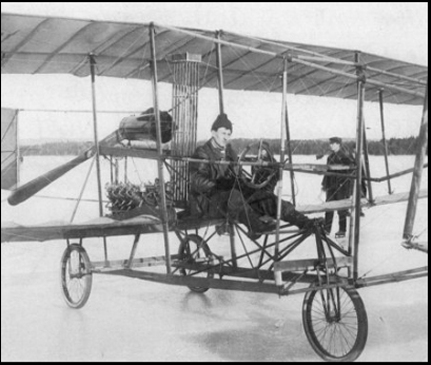
1886-1961 |
 |
|
Back in 1909 the flight of this aircraft made Canadian history when John A. McCurdy flew it for over half a mile above the frozen surface of Bras d'Or Lake at Baddeck Bay, N.S. Recognized as the first flight by a British subject at any point in the British Commonwealth, and the first airplane to fly in Canada, the Silver Dart, was built by a group known as the Aerial Experiment Association. Frank Ellis in his book, "Canada's Flying Heritage" (published by the University of Toronto Press) reveals that the Association consisted of three people--Dr. Alexander Graham Bell, John McCurdy and Frederick (Casey) Baldwin; the expenses of the trio were underwritten by Mrs. Bell. It was a famous group, for Dr. Bell had invented the telephone, and Baldwin was the first British subject ever to fly (a flight he made in the U.S.A.). McCurdy later became lieutenant-governor of Nova Scotia. Autographed copies of Ellis' book, "Canada's Flying Heritage" can be obtained through the EB treasurer's office. |
 |
| THE BELL FAMILY & NATIONAL GEOGRAPHIC SOCIETY |
|
An early flight enthusiast, Dr. Alexander Graham Bell (center) formed an experimental group in 1907 to "build a practical aeroplane that
will carry a man." Shown with Bell at his Nova Scotia home are (left to right) Glenn H. Curtiss,
John McCurdy, F.W. Baldwin, and Lieutenant Thomas E. Selfridge. The Story of the Early Birds by Henry Serrano Villard |
|
Bell had gathered around him at Baddeck a group of bright young men, including two recent graduates in mechanical engineering of the University of Toronto: Frederick Walker ("Casey") Baldwin (no relation to the balloonist) and John A. D. McCurdy, son of an inventor, who was to mature into one of America's foremost aviators |
 |
Courtesy of the Smithsonian Institution |
|
With the achievements of the Silver Dart, the activities of the Aerial Experiment Association came to an end. Its point proven, the society was dissolved. Bell went back to his kites and died in 1922; his simple grave, marked by a boulder with a plaque atop the hill overlooking his summer home and the lakes he loved so well, fittingly commemorates the twenty-five years of his life that he consecrated to the development of flying. McCurdy and Baldwin became the fathers of Canadian aviation, helping to found the first Canadian aircraft manufacturer---the short-lived Canadian Aerodrome Company. One of the five machines it produced was tested for the Canadian army at Petawawa, Ontario, in the summer of 1909. With McCurdy at the controls it landed in a rough field---quite in contrast to the smooth ice at Baddeck--- and disintegrated. McCurdy escaped with a broken nose (the only injury he ever received in his flying career), while the army took the accident as proof that the aeroplane had no practical use in warfare. Curtiss went on to develop the compact pusher biplane that was to set many records in the years to come. And when Canadians failed to summon enthusiasm over the prospects of powered flight, Baldwin returned to the United States for new experiments with a Curtiss-designed hydroaeroplane, while McCurdy became the chief pilot for Curtiss---the first to take a "flying boat" into the air and the first (in August 1910 at Sheepshead Bay, N.Y.) to transmit a wireless message from a plane. The Story of the Early Birds by Henry Serrano Villard |
|
Daily Journal and Tribune, Knoxville, Tennessee: June 30, 1910, Transcribed by Bob Davis - 9-4-03 Bob Davis |
 |
|
INTERNATIONAL AVIATION MEET 1911 from the original Post Card Courtesy of Jean-Pierre Lauwers |
 |
|
AT SHEEPSHEAD BAY Photographed by Albert H. Reiners |


|